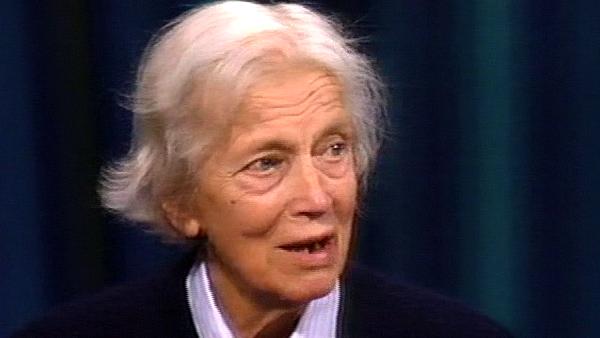I mean, what we were working on at that moment was just putting the... getting the system working. I mean, the... one had to have something representing atoms, so he [Charles Bunn] had, in fact, circles of different size, and... which he photographed through the fly's eye spread of pinholes. And he had to check up what size corresponded to what kind of atom. But he managed, he did most, all of that, and I just... standing near really at that particular time, and seeing the first trials go on, testing out the distribution of atoms with the... through the pinholes array to get an array of intensities which should correspond to the projection down the B-axis of the structure as a whole.
I didn't get very... we didn't get very far with it then, and I went back to Oxford for the next term, and he always supposed he shouldn't really work at it, because he was working at whatever ICI had told him to do during his working hours, and he would just work at penicillin in the evening, until, mercifully... what was his name? The head of ICI altogether? Lord... I don't remember.
[Q] The head of ICI?
Wasn't Sir Robert Vantage it was his brother, wasn't it? Came in Monday, and he noticed some papers lying about with penicillin written on them, and said to Charles, the others being about in the room, listening, 'Oh, I am glad you are working on this'. And after that, when I came back, I found that penicillin was properly stamped on all the bits of relevant paper. Job number whatever-it-was, I forget.
[Q] So how long did it take to get to the final solution?
Well, there was a long hold-up during the summer, where nothing much was really reached or done, and I went, unfortunately, into this stupid situation, I became pregnant and had a miscarriage, and didn't work then, longer.
When I got back to Oxford, I found a letter from Charles asking, for a little more information about my first observations, and particularly the optics of the sodium salt, so I sent him these. And after that, he made a whole plan of what the molecule was like, and... and started moving it about over the area, and getting more different pinhole effects, until he found one that seemed quite good. And we in the meantime had done, essentially, the same for the potassium and sodium salts... the potassium and rubidium salts. We had found the heavy atom positions, calculated the sign contribution, which didn't give us signs for all the array, but about half of it. Then we calculated the electron density maps of the potassium and rubidium salts, which we knew must be imperfect, because there were some terms left out.
Then Charles sent me the electron density map, which he had reached by his trial and error operation, and I drew it out to the same scale as the other ones, and... well, I meant to bring it with me, but couldn't find, couldn't find it in time, the two sheets: you just put together, put one on top of the other and move them one over one another to find which bits hang together, because the arrangement of the molecules are different. That's quite quickly done, I used to make people do it in, through an afternoon visiting the lab. And then you immediately can see, from the sort of group that fits together and constitutes one molecule, where the phenyl group must be, and where the thiazolidine group must be, and in between, presumably the oxazolone ring or the beta-lactam ring. So at first we postulated an oxazolone ring and calculated the next highest intensities and found their signs. Mostly, what we did was, after not much in the way of calculations, we had these structure factor graphs drawn out, and we just put the map of the atomic positions over the top, and calculated extremely roughly 20, 10, so on, what we thought the contribution to the three of the new terms, and so we found how the signs were changing. Then we calculated a new map with perhaps just five extra terms in it, and immediately we began to see that the atoms which were given the oxazolone position moved the ring, broke open, and the atoms moved into the beta-lactam position.







